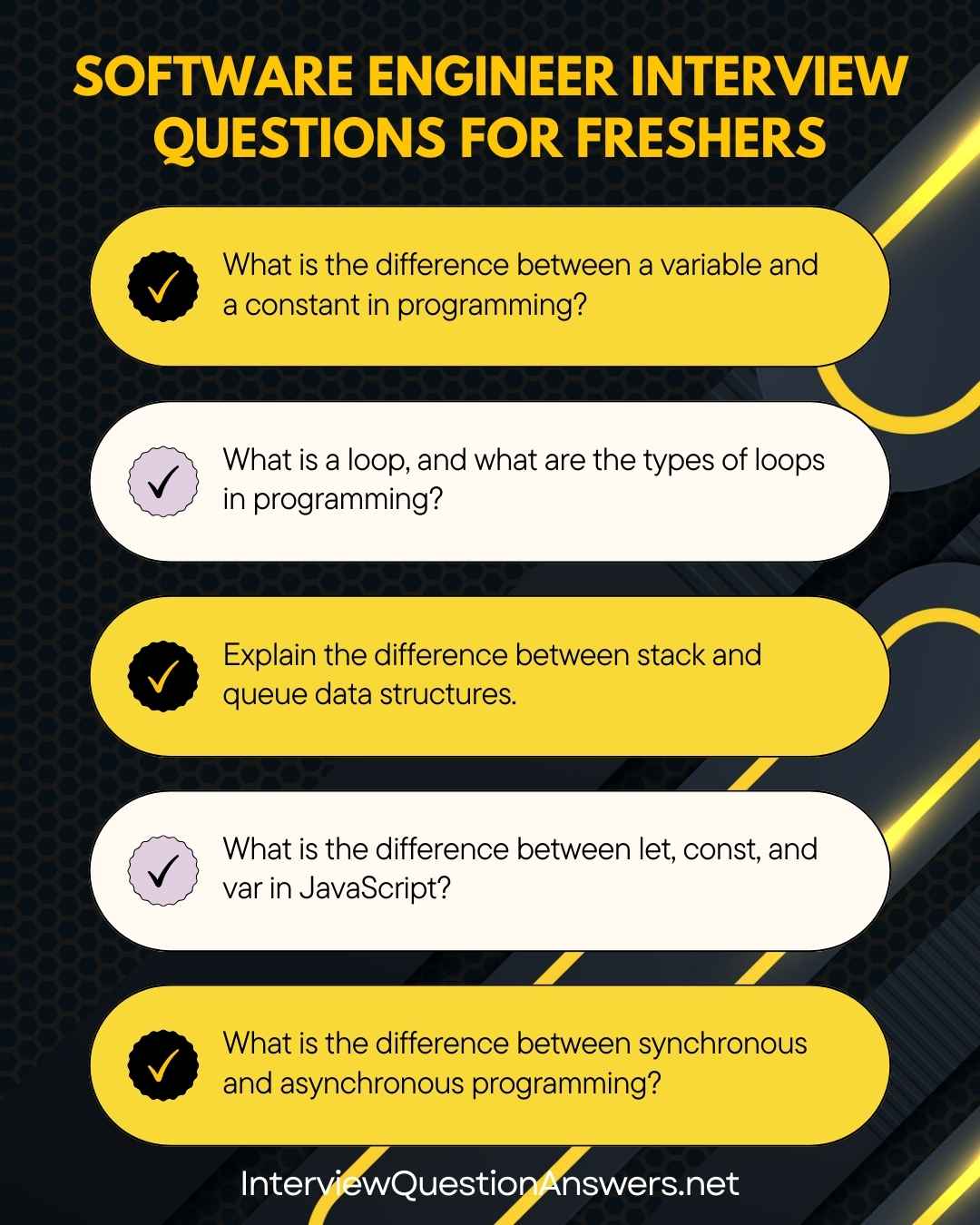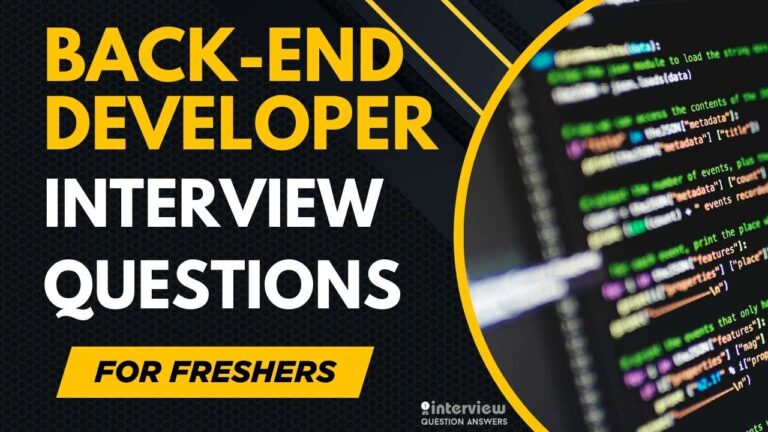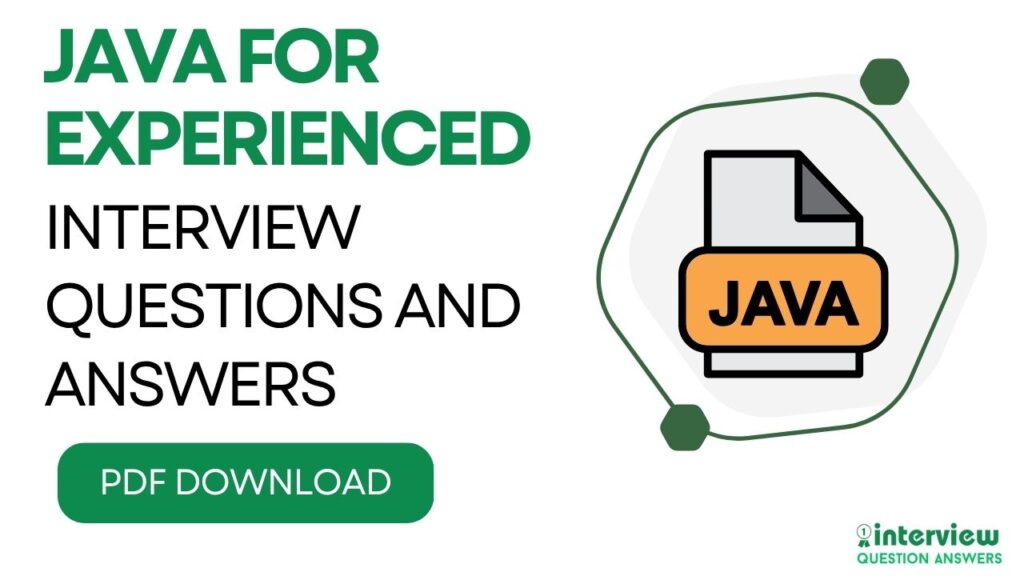Software Engineer Interview Questions for Freshers
Software Engineer Interview Questions for Freshers focus on fundamental programming concepts, problem-solving abilities, and coding best practices that entry-level candidates must demonstrate. Breaking into software engineering requires mastering both theoretical computer science knowledge and practical development skills that employers seek from new programming professionals.
Here we are covering Software Engineer Interview Questions for Freshers seeking their first role in software development, addressing data structures, algorithms, object-oriented programming, and system design basics. These Software Engineer Interview Questions for Freshers will help you showcase your technical abilities, understanding of software development lifecycle, and readiness to build robust applications in today’s technology-driven development environment.
Basic Software Engineer Interview Questions for Freshers
Que 1. What is the difference between a variable and a constant in programming?
Answer:
A variable is a named storage location whose value can change during program execution, while a constant’s value is fixed once defined. For example, in Python, x = 5 is a variable, but const PI = 3.14 in languages like JavaScript (using const) is a constant.
Que 2. Explain the concept of object-oriented programming (OOP).
Answer:
OOP is a programming paradigm based on objects, which combine data (attributes) and behavior (methods). Key principles include encapsulation, inheritance, polymorphism, and abstraction, enabling modular, reusable, and maintainable code.
Que 3. What is a loop, and what are the types of loops in programming?
Answer:
A loop repeatedly executes a block of code until a condition is met. Common types include for (iterates over a sequence), while (runs until a condition is false), and do-while (executes at least once before checking the condition).
Que 4. What is the difference between a function and a method?
Answer:
A function is a standalone block of code performing a task, while a method is a function belonging to a class or object in OOP. For example, in Python, len("string") is a function, but string.upper() is a method.
Que 5. What is the purpose of version control systems like Git?
Answer:
Version control systems track changes to code, enabling collaboration, rollback, and history tracking. Git allows multiple developers to work on the same project, manage branches, and merge changes efficiently.
Que 6. How do you handle errors in programming?
Answer:
Use error-handling mechanisms like try-catch blocks (e.g., in Python, try/except). Validate inputs, log errors for debugging, and provide user-friendly messages. For example:
try:
result = 10 / 0
except ZeroDivisionError:
print("Cannot divide by zero")Que 7. What is the difference between == and === in JavaScript?
Answer:== checks for equality with type coercion (e.g., "5" == 5 is true), while === checks for strict equality without coercion (e.g., "5" === 5 is false). Always use === for predictable comparisons.
Que 8. What is a data structure, and why is it important?
Answer:
A data structure organizes and stores data for efficient access and manipulation (e.g., arrays, lists, stacks, queues). They are critical for optimizing algorithms, reducing time complexity, and solving problems effectively.
Que 9. Explain the difference between stack and queue data structures.
Answer:
A stack follows Last-In-First-Out (LIFO), where the last element added is removed first (e.g., function call stack). A queue follows First-In-First-Out (FIFO), where the first element added is removed first (e.g., task scheduling).
Que 10. What is an algorithm, and why is time complexity important?
Answer:
An algorithm is a step-by-step procedure to solve a problem. Time complexity (e.g., O(n), O(log n)) measures how an algorithm’s runtime grows with input size, critical for ensuring performance in large-scale applications.
Que 11. How do you reverse a string in Python?
Answer:
Reverse a string using slicing, a loop, or reversed(). The most concise method is slicing:
text = "hello"
reversed_text = text[::-1] # Returns "olleh"Que 12. What is the difference between a list and a tuple in Python?
Answer:
A list is mutable (can be modified), defined with [], while a tuple is immutable, defined with (). Lists are used for dynamic data; tuples for fixed data, with better memory efficiency.
my_list = [1, 2, 3] # Mutable
my_tuple = (1, 2, 3) # ImmutableQue 13. What is the purpose of the this keyword in JavaScript?
Answer:
The this keyword refers to the current object in context, depending on how a function is called (e.g., global object, object method, or constructor). Use arrow functions to avoid this binding issues.
const obj = {
name: "Test",
getName: function() { return this.name; }
};
console.log(obj.getName()); // "Test"Que 14. What is the difference between SQL and NoSQL databases?
Answer:
SQL databases (e.g., MySQL) are relational, use structured tables, and support SQL queries. NoSQL databases (e.g., MongoDB) are non-relational, handle unstructured data, and scale horizontally, suitable for flexible, high-volume data.
Que 15. How do you write a basic SQL SELECT query?
Answer:
A SELECT query retrieves data from a database table. Specify columns and use WHERE for filtering.
SELECT name, age FROM users WHERE age > 18;Que 16. What is the purpose of an API in software development?
Answer:
An API (Application Programming Interface) enables communication between software systems by defining request-response formats. For example, a REST API allows a frontend to fetch data from a backend server.
Que 17. What is the difference between let, const, and var in JavaScript?
Answer:var is function-scoped and hoisted, allowing redeclaration. let is block-scoped and supports reassignment. const is block-scoped and immutable for the binding (but object properties can change). Prefer let or const for modern JavaScript.
let x = 1; // Reassignable
const y = 2; // Not reassignable
var z = 3; // Legacy, avoidQue 18. How do you check if a number is prime in Python?
Answer:
Write a function to check if a number is divisible only by 1 and itself, iterating up to its square root for efficiency.
def is_prime(n):
if n < 2:
return False
for i in range(2, int(n ** 0.5) + 1):
if n % i == 0:
return False
return TrueQue 19. What is recursion, and when should you use it?
Answer:
Recursion is when a function calls itself to solve smaller instances of a problem (e.g., factorial calculation). Use it for problems like tree traversal, but avoid deep recursion to prevent stack overflow. Always include a base case.
def factorial(n):
if n == 0: # Base case
return 1
return n * factorial(n - 1)Que 20. What is the difference between synchronous and asynchronous programming?
Answer:
Synchronous code executes sequentially, blocking further execution until complete (e.g., a loop). Asynchronous code allows non-blocking operations (e.g., API calls) using callbacks, promises, or async/await in JavaScript, improving performance for I/O-bound tasks.
async function fetchData() {
const res = await fetch('https://api.example.com/data');
return res.json();
}Que 21. How do you remove duplicates from an array in JavaScript?
Answer:
Use Set for a concise solution or a loop for manual control. Set automatically removes duplicates, and Array.from() converts it back to an array.
const arr = [1, 2, 2, 3];
const unique = [...new Set(arr)]; // Returns [1, 2, 3]Que 22. What is the purpose of the main() function in programming?
Answer:
The main() function serves as the entry point for program execution in languages like C++ or Java. In Python, use if __name__ == "__main__": to ensure code runs only when the script is executed directly.
if __name__ == "__main__":
print("Program started")Que 23. How do you find the maximum element in an array?
Answer:
Use a loop to compare elements or built-in functions like max() in Python or Math.max(...arr) in JavaScript.
arr = [1, 5, 3]
max_value = max(arr) # Returns 5Que 24. What is the difference between a shallow copy and a deep copy?
Answer:
A shallow copy duplicates the top-level structure but shares nested objects (e.g., slice() in JavaScript). A deep copy duplicates all levels, creating independent copies (e.g., json.deepcopy() in Python).
import copy
lst = [[1, 2], 3]
shallow = copy.copy(lst)
deep = copy.deepcopy(lst)Que 25. How do you debug a program to find errors?
Answer:
Use print statements, debuggers (e.g., VS Code debugger), or logging to trace execution. Check error messages, use breakpoints to inspect variables, and test with small inputs to isolate issues. Tools like Chrome DevTools are useful for JavaScript debugging.

Also Check: Software Engineer Interview Questions for Experienced
Advanced Software Engineer Interview Questions for Freshers
Que 26. What is the difference between a process and a thread in operating systems?
Answer:
A process is an independent program with its own memory space and system resources, while a thread is a lightweight execution unit within a process, sharing the same memory. Threads enable concurrency within a process but require synchronization to avoid race conditions.
# Example using Python threading
import threading
def task():
print("Thread running")
thread = threading.Thread(target=task)
thread.start()
thread.join()Que 27. How do you implement a binary search algorithm, and what are its prerequisites?
Answer:
Binary search divides a sorted array to find a target value, with O(log n) time complexity. Prerequisites: the array must be sorted. Compare the target with the middle element, then search the left or right half recursively.
def binary_search(arr, target):
left, right = 0, len(arr) - 1
while left <= right:
mid = (left + right) // 2
if arr[mid] == target:
return mid
elif arr[mid] < target:
left = mid + 1
else:
right = mid - 1
return -1Que 28. What is a closure in JavaScript, and how is it used?
Answer:
A closure is a function that retains access to its lexical scope’s variables even after the outer function has executed. Useful for data encapsulation and creating private variables.
function outer() {
let count = 0;
return function inner() {
return count++;
};
}
const counter = outer();
console.log(counter()); // 0
console.log(counter()); // 1Que 29. How do you optimize a database query for performance?
Answer:
Optimize queries by indexing frequently queried columns, avoiding SELECT *, and using specific columns. Minimize joins, use query execution plans to identify bottlenecks, and leverage caching (e.g., Redis) for repetitive queries. For example, in SQL:
CREATE INDEX idx_name ON users(name);
SELECT name FROM users WHERE age > 18;Que 30. What is the difference between REST and GraphQL APIs?
Answer:
REST uses fixed endpoints with HTTP methods (GET, POST), returning structured data. GraphQL uses a single endpoint, allowing clients to request specific fields, reducing over/under-fetching. GraphQL supports real-time updates via subscriptions, while REST relies on polling or WebSockets.
Que 31. How do you implement a queue using two stacks?
Answer:
Use two stacks: one for enqueue (push) and one for dequeue (pop). On dequeue, transfer elements from the enqueue stack to the dequeue stack if empty, ensuring FIFO order.
class Queue:
def __init__(self):
self.stack1 = []
self.stack2 = []
def enqueue(self, item):
self.stack1.append(item)
def dequeue(self):
if not self.stack2:
while self.stack1:
self.stack2.append(self.stack1.pop())
return self.stack2.pop() if self.stack2 else NoneQue 32. What is event-driven programming, and how is it implemented in Node.js?
Answer:
Event-driven programming responds to events (e.g., user actions, messages) via event listeners. In Node.js, the EventEmitter class handles events, allowing asynchronous, non-blocking operations.
const EventEmitter = require('events');
const emitter = new EventEmitter();
emitter.on('greet', () => console.log('Hello!'));
emitter.emit('greet');Que 33. How do you prevent SQL injection in a web application?
Answer:
Use parameterized queries or prepared statements to separate SQL code from user input. Validate and sanitize inputs, and use ORMs (e.g., SQLAlchemy) to abstract queries. For example:
# Using SQLAlchemy
from sqlalchemy.sql import text
query = text("SELECT * FROM users WHERE id = :id")
result = connection.execute(query, {"id": user_id})Que 34. What is a design pattern, and can you explain the Singleton pattern?
Answer:
A design pattern is a reusable solution to common software problems. The Singleton pattern ensures a class has only one instance, providing global access. Useful for managing shared resources like database connections.
class Singleton:
_instance = None
def __new__(cls):
if cls._instance is None:
cls._instance = super().__new__(cls)
return cls._instanceQue 35. How do you handle memory leaks in a JavaScript application?
Answer:
Identify leaks using Chrome DevTools’ memory profiler. Avoid global variables, clear event listeners, and use weak references (e.g., WeakMap). For example, remove listeners on cleanup:
const btn = document.querySelector('button');
const handler = () => console.log('Clicked');
btn.addEventListener('click', handler);
btn.removeEventListener('click', handler); // CleanupQue 36. What is the difference between a binary tree and a binary search tree?
Answer:
A binary tree is a tree where each node has up to two children. A binary search tree (BST) is a binary tree where the left child’s value is less than the parent’s, and the right child’s is greater, enabling efficient searching (O(log n) ideally).
Que 37. How do you implement rate limiting in a web application?
Answer:
Implement rate limiting using middleware (e.g., express-rate-limit in Node.js) or server-side logic. Track requests per user/IP in memory (Redis) or a database, enforcing limits (e.g., 100 requests/hour).
const rateLimit = require('express-rate-limit');
app.use(rateLimit({
windowMs: 60 * 1000, // 1 minute
max: 100 // 100 requests per minute
}));Que 38. What is a hash table, and how does it handle collisions?
Answer:
A hash table maps keys to values using a hash function for O(1) access. Collisions (when keys hash to the same index) are resolved via separate chaining (linked lists) or open addressing (probing). Python’s dict is an example.
Que 39. How do you implement a basic REST API in Python using Flask?
Answer:
Use Flask to create endpoints for CRUD operations, handling HTTP methods like GET, POST, and DELETE. Return JSON responses and handle errors.
from flask import Flask, jsonify, request
app = Flask(__name__)
@app.route('/api', methods=['GET'])
def get_data():
return jsonify({"message": "Hello, World!"})
if __name__ == '__main__':
app.run()Que 40. What is the difference between synchronous and asynchronous I/O operations?
Answer:
Synchronous I/O blocks execution until the operation completes (e.g., file reading). Asynchronous I/O allows other tasks to run concurrently, using callbacks, promises, or async/await. For example, in Node.js:
const fs = require('fs').promises;
async function readFile() {
const data = await fs.readFile('file.txt', 'utf8');
console.log(data);
}Que 41. How do you implement a depth-first search (DFS) on a graph?
Answer:
DFS traverses a graph by exploring as far as possible along each branch before backtracking, using recursion or a stack. Useful for pathfinding or cycle detection.
def dfs(graph, node, visited=None):
if visited is None:
visited = set()
visited.add(node)
for neighbor in graph[node]:
if neighbor not in visited:
dfs(graph, neighbor, visited)
return visitedQue 42. What is the purpose of dependency injection in software design?
Answer:
Dependency injection provides dependencies to a class externally (e.g., via constructor), improving modularity and testability. It reduces tight coupling and simplifies mocking in tests.
class Service:
def __init__(self, db):
self.db = db # Dependency injected
def fetch_data(self):
return self.db.query()Que 43. How do you optimize a web application for low-latency responses?
Answer:
Use caching (e.g., Redis, Varnish), optimize database queries with indexing, and implement CDNs (e.g., CloudFront) for static assets. Minimize server-side processing with asynchronous tasks and compress responses with Gzip.
Que 44. What is the difference between a stack and a heap in memory management?
Answer:
The stack stores function call frames and local variables with fixed-size allocation (LIFO). The heap stores dynamically allocated objects, managed by a garbage collector or manual allocation, allowing flexible memory use but slower access.
Que 45. How do you implement a linked list in Python?
Answer:
Create a Node class for elements and a LinkedList class to manage them, supporting operations like append or delete.
class Node:
def __init__(self, data):
self.data = data
self.next = None
class LinkedList:
def __init__(self):
self.head = None
def append(self, data):
new_node = Node(data)
if not self.head:
self.head = new_node
else:
current = self.head
while current.next:
current = current.next
current.next = new_nodeQue 46. What is a promise in JavaScript, and how does it work?
Answer:
A promise represents an asynchronous operation’s eventual completion or failure, with states: pending, fulfilled, or rejected. Use .then() for success and .catch() for errors.
const promise = new Promise((resolve, reject) => {
setTimeout(() => resolve("Success"), 1000);
});
promise.then(result => console.log(result)).catch(err => console.error(err));Que 47. How do you handle cross-site scripting (XSS) in a web application?
Answer:
Sanitize user inputs using libraries like DOMPurify, escape HTML outputs, and set Content Security Policy (CSP) headers. Avoid eval() and validate data on both client and server sides.
Que 48. What is the difference between a monolithic and microservices architecture?
Answer:
Monolithic architecture combines all components into a single application, simpler to develop but harder to scale. Microservices split functionality into independent services, enabling scalability and independent deployment but increasing complexity.
Que 49. How do you implement a priority queue in Python?
Answer:
Use the heapq module to implement a priority queue, where elements are stored in a heap with priority-based ordering.
import heapq
class PriorityQueue:
def __init__(self):
self.queue = []
def push(self, item, priority):
heapq.heappush(self.queue, (priority, item))
def pop(self):
return heapq.heappop(self.queue)[1]Que 50. How do you test a REST API during development?
Answer:
Use tools like Postman or cURL to send HTTP requests, validate responses, and check status codes. Write automated tests with frameworks like pytest (Python) or Jest (JavaScript), mocking dependencies to ensure endpoint reliability.
# Using pytest with requests
import requests
def test_api():
response = requests.get('https://api.example.com/data')
assert response.status_code == 200Conclusion
We have already shared the essential questions for Software Engineer Interview Questions for Freshers. This comprehensive Software Engineer Guide includes interview questions for fresh graduates, covering both basic and advanced concepts that employers commonly evaluate. The software engineering industry is rapidly evolving with cloud-native development, microservices architecture, and DevOps practices becoming standard requirements for entry-level positions.
These Software Engineer Interview Questions for Freshers provide the technical foundation needed to succeed in your job search, covering coding fundamentals to software architecture principles. With proper preparation using these Software Engineer Interview Questions for Freshers and understanding current industry demands, you’ll be well-positioned to launch your software engineering career.
Similar Interview Guides:













